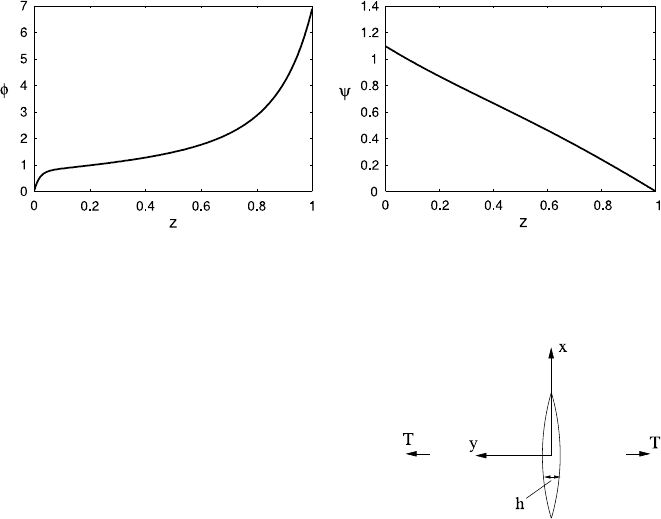Fowler A. Mathematical Geoscience
Подождите немного. Документ загружается.


570 9 Magma Transport
then (9.69) becomes
−2ΦΦ
Z
+ν
φ
2
ψ
Z
Z
=δ
3/2
ΦΨ,
w[1 −˜νΨ
Z
+Φ
Z
]=ΦΨ +
ε
δ
1/2
Ψ
ZZ
;
(9.79)
the matching conditions are
Φ ∼
νw
Z
,Ψ∼
Z
ν
as Z →∞. (9.80)
To leading order, we have
−Φ
2
+νΦ
2
Ψ
Z
=0, (9.81)
and thus
Ψ =
Z
ν
, (9.82)
so that Ψ =0atZ =0. To leading order, Φ then satisfies
w(1 +Φ
Z
) =
ZΦ
ν
, (9.83)
and the (unique) solution which matches to the outer solution is
Φ =
∞
Z
exp
Z
2
−s
2
2νw
ds; (9.84)
in particular, Φ =(νwπ/2)
1/2
on Z =0, i.e.
φ ≈
νwπ
2δ
1/2
on z =1. (9.85)
Figure 9.15 shows a numerical solution of the equations, which clearly shows the
boundary layer structure described above.
One of the more important consequences of this model and its solution is the
inference that the effective pressure ψ ∝p
s
−p
l
reaches zero at the upper bound-
ary where refreezing occurs. Since in practice the partial melting produces a buoy-
ant upwelling and thus a tensile stress in the mantle, this suggests that fracturing
is likely to occur at this interface, affording the possibility of magma migration
through the lithosphere. The fact that magma does indeed ascend through the litho-
sphere more or less implies that this does occur, but the formulation of the coupled
fractured/porous transport is not such an easy thing to carry out. Instead, we now
turn to the dynamic problem of describing how such fracture-driven transport can
occur.

9.5 Magmafracturing in the Lithosphere 571
Fig. 9.15 Numerical solution for φ and ψ of Eqs. (9.69) with the boundary conditions (9.70),
using values ν = 0.8, ˜ν = 0.12, w = 1, δ = 0.02, ε = 1.2 × 10
−3
. Very kindly provided by Ian
Hewitt
Fig. 9.16 A linear crack in
an elastic medium. A tension
T acts on the medium,
causing the crack to have a
width h
9.5 Magmafracturing in the Lithosphere
As magma oozes upwards in the asthenosphere, it ought to freeze as it reaches the
cold temperature of the lithosphere. The fact that magma reaches the surface of the
Earth implies that transport through the lithosphere is rapid, and the only apparent
way this can be accommodated is by the process of ‘magmafracturing’ (by analogy
to hydrofracturing). The buoyant magma flows rapidly upwards in a conduit known
as a dyke, which is opened in the same way that a fracture propagates in a brittle
material. The speed of ascent, of the order of metres per second, is sufficiently rapid
that the lithosphere can be taken to respond elastically, and thus the width of the
crack is determined in terms of the fluid pressure by quasi-static fracture mechanics
(because the fluid speed is much less than the elastic wave speeds). To describe this
relationship, we now discuss linear elastic fracture mechanics.
9.5.1 Fracture Mechanics
We begin by dealing fairly generally with a crack as shown in Fig. 9.16.Wetake
axes x and y as shown, and consider the opening of a two-dimensional crack of
small width h when subjected to a tension T at infinity superimposed on a lithostatic
pressure p
0
−ρ
s
gx. The fluid pressure in the crack is taken to be p. In conditions

572 9 Magma Transport
of plane strain, the displacement vector has components (u, v), and the constitutive
law for linear elasticity
σ
ij
=2με
ij
+λδ
ij
ε
kk
, (9.86)
where λ and μ are the Lamé coefficients, takes the simple form
σ
1
=2μu
x
+λ(u
x
+v
y
),
σ
2
=2μv
y
+λ(u
x
+v
y
),
τ =μ(u
y
+v
x
);
(9.87)
x and y subscripts denote partial derivatives, and the three independent components
of the stress tensor are σ
1
≡σ
11
, σ
2
≡σ
22
, τ ≡σ
12
. The equations of motion are
∂σ
1
∂x
+
∂τ
∂y
−ρ
s
g =0,
∂τ
∂x
+
∂σ
2
∂y
=0.
(9.88)
We introduce complex variables
z =x +iy, ¯z =x −iy, (9.89)
and then the force balance equations can be written together as
∂
∂z
[σ
1
−σ
2
+2iτ]+
∂
∂ ¯z
(σ
1
+σ
2
) +
∂V
∂ ¯z
=0, (9.90)
where we define the real-valued potential
V =−ρ
s
g(z +¯z). (9.91)
The complex displacement is
D =u +iv, (9.92)
and then we find
σ
1
+σ
2
=2(λ +μ)(D
z
+
¯
D
¯z
),
σ
1
−σ
2
+2iτ =4μD
¯z
.
(9.93)
From this we find that the force balance equations can be written in the form
∂
∂z
[4μD
¯z
]+
∂
∂ ¯z
2(λ +μ)(D
z
+
¯
D
¯z
)
+
∂V
∂ ¯z
=0, (9.94)
and thus there is a first integral
4μD
z
+2(λ +μ)(D
z
+
¯
D
¯z
) +V =
4(λ +2μ)
λ +μ
Ω
(z), (9.95)

9.5 Magmafracturing in the Lithosphere 573
where Ω(z) is an as yet arbitrary analytic function (the pre-multiplying coefficient
is chosen for later algebraic simplicity).
We can solve this by firstly deriving an expression for D
z
and then integrating,
to find
2μD =−
μX
2(λ +2μ)
+(¯z −z)
Ω
(z) +κΩ(z) +φ(¯z), (9.96)
where we define
∂X
∂z
=V, κ =
λ +3μ
λ +μ
, (9.97)
and φ is an arbitrary analytic function of ¯z (more precisely: φ(z) is an analytic
function of z, but its argument in (9.96)is¯z). See also Question 9.9.Fromthe
expressions in (9.93), we can now deduce the forms
σ
1
+σ
2
=2
Ω
(z) +Ω
(z)
−
(λ +μ)V
λ +2μ
,
σ
1
−σ
2
+2iτ =−
μV
λ +2μ
+2
Ω
(z) +2(¯z −z)Ω
(z) +2φ
(¯z),
σ
2
−iτ =−
λV
2(λ +2μ)
+Ω
(z) −(¯z −z)Ω
(z) −φ
(¯z),
(9.98)
where we have used the fact that we can choose
∂X
∂ ¯z
=V (9.99)
(by choosing X to be real, explicitly X =−
1
2
ρ
s
g(z +¯z)
2
).
So far this is all quite general. Now we consider the situation shown in Fig. 9.16.
There is a crack which we denote by L on the x-axis, across which the functions Ω
and φ will typically be discontinuous; thus L will be a branch cut for these functions.
The boundary conditions for the stresses can be expressed in the form
σ
1
+σ
2
→−2p
0
+ρ
s
g(z +¯z),
σ
1
−σ
2
+2iτ →−2T as z →∞,
(9.100)
and
σ
2
−iτ =−p,
2μ[D]
+
−
=2iμh for z ∈L,
(9.101)
where p denotes the fluid pressure in the crack, and [D]
+
−
=D
+
−D
−
denotes the
jump in D across L, from y =0− to y =0+.
Now note that, for any function g(z), g(¯z)
+
=g(z)
−
and g(¯z)
−
=g(z)
+
. Since
σ
2
−iτ is continuous across L, we see from (9.98) that
Ω
(z) −φ
(¯z)
+
−
=0, (9.102)

574 9 Magma Transport
and thus that Ω
(z) +φ
(z) is an entire function. To ascertain what it is, we need the
limiting behaviours of Ω
and φ
at ∞. These we obtain from (9.98) and (9.100);
using the definition of V in (9.91), we find
Ω
(z) ∼−
1
2
p
0
+
μρ
s
gz
2(λ +2μ)
,
φ
(¯z) ∼−T +
1
2
p
0
−
3μρ
s
g¯z
2(λ +2μ)
as z →∞,
(9.103)
from which it follows that
Ω
(z) +φ
(z) =−T −
μρ
s
gz
λ +2μ
. (9.104)
Substituting for φ
(¯z) in (9.98)
3
, and letting z → x + i0 (thus Ω
(z) → Ω
+
(x),
Ω
(¯z) →Ω
−
(x)), we then find
Ω
+
+Ω
−
=−T −
λ +μ
λ +2μ
ρ
s
gx −p on L. (9.105)
A second condition on L follows from (9.101)
2
. Using the fact that Ω + φ is
analytic, (9.96)impliesthat
[2μD]
+
−
=(1 +κ)(Ω
+
−Ω
−
), (9.106)
and thus (9.101)
2
yields
Ω
+
−Ω
−
=
2iμh
1 +κ
on L. (9.107)
Together with the boundary condition (9.103)
1
,(9.107) provides a Hilbert problem
for the determination of Ω in terms of h;(9.105) then determines the crack fluid
pressure p in terms of h.
The solution of (9.107) with (9.103)
1
is
Ω(z) =
1
2πi
L
2iμh(s)ds
(1 +κ)(s −z)
−
1
2
p
0
z +
μρ
s
gz
2
4(λ +2μ)
, (9.108)
from which the Plemelj formulae imply
Ω
+
+Ω
−
=
1
πi
−
L
2iμh(s)ds
(1 +κ)(s −x)
−p
0
x +
μρ
s
gx
2
2(λ +2μ)
. (9.109)
Differentiating this and using (9.105), we finally obtain
p =P −
μ
2π(1 −ν)
−
L
∂h
∂s
ds
s −x
, (9.110)

9.5 Magmafracturing in the Lithosphere 575
where
P = p
0
−T −ρ
s
gx (9.111)
is the lithostatic compressive normal stress, and
ν =
λ
2(λ +μ)
(9.112)
is Poisson’s ratio.
9.5.2 Magma Dynamics
So far we have not specified anything about the crack L. Now we consider a sit-
uation which is appropriate to the formation of a dyke growing upwards from the
asthenosphere. We imagine that the dyke originates at the asthenosphere, where we
take x = 0, and a flux of magma Q(t) is injected into the crack. We suppose, not
very realistically, that the crack can be represented as having a symmetric extension
below the asthenosphere, so that the crack L is the interval (−l,l), where l(t) is the
lithospheric length of the crack, but we are concerned only with the region x>0.
The crack is thin, in the sense that its width h l, and thus the fluid flow in the
crack is given by the local Poiseuille flow law
q =−
h
3
12η
m
∂p
∂x
+ρ
m
g
, (9.113)
where q is the fluid flux per unit transverse width of the crack, η
m
is the magma
viscosity, and ρ
m
is the magma density. Conservation of mass of fluid in the crack
requires
∂h
∂t
+
∂q
∂x
=0. (9.114)
The three Eqs. (9.114), (9.113) and (9.110) provide the elastohydrodynamic model
for magmafracturing in the lithosphere.
9.5.3 Stress Intensity Factor
One boundary condition which we apply for (9.114) is the specified flux at the inlet:
q =Q(t) at x =0. (9.115)
Another condition is necessary at the crack tip, and this is determined by a quantity
called the stress intensity factor.

576 9 Magma Transport
The stress intensity factor is associated with the stress field generated by a crack
in a medium. In the simplest situation, a uniform crack overpressure σ generates a
singular stress field in the solid, which has the asymptotic form
σ
ij
=
K
√
2πr
f
ij
(θ), (9.116)
where the quantity K is known as the stress intensity factor, and the polar angle θ is
measured from an axis along, and in the opposite direction to, the crack. For mode
I cracks such as those considered here, we may define
K = lim
x→l+
√
2πxσ
2
|
y=0
. (9.117)
For a crack of length 2l, the stress intensity factor is
K =Yσ
√
πl, (9.118)
where Y is an O(1) numerical factor, associated with the crack geometry and the
conditions of loading.
Cracks can exist as perfectly good stationary features in an elastic medium, but
it is found that if the induced stress intensity factor K is large enough, then a crack
will grow. There is a critical stress intensity factor K
c
, such that when K reaches K
c
,
dynamic fracture occurs, and crack growth occurs at near elastic wave speeds—very
rapidly—and elastic waves are generated which propagate away from the source.
These are the seismic waves associated with crack propagation in earthquakes.
However, crack growth also occurs at values of K<K
c
, albeit less rapidly. This
is the phenomenon of subcritical crack propagation due to ‘stress corrosion’, and is
familiar to us all in the cracks that migrate slowly across a pane of glass. A grander
example is the rifting event which broke up Gondwanaland to form the Atlantic
ocean. The crack propagated from south to north over a period of tens of millions
of years.
It is found experimentally that the crack tip speed v is an increasing function of
K, becoming very large as K →K
c
. At low values of K, it becomes exponentially
small, and at higher values it reaches a plateau, before its asymptotic rise near K
c
.
The growth of cracks is essentially a thermodynamic process, being facilitated by
the release of energy to form new crack surface and thus surface energy. At K =K
c
,
this energy is directly released from the stored elastic energy in the medium. At
lower K, this is not enough, and the energy is thought to be supplied from chemical
or potential energy of the fluid which migrates into the crack. It is then supposed
that the crack speed is determined by the rate-limiting energy supply mechanism.
At very low K, this is due to diffusion of chemical corrosive agents to the crack tip
(hence the term stress corrosion), and on the plateau at higher K, it is thought to be
controlled by the rate of fluid migration to the crack tip.
It is this plateau region which is relevant here, and thus we may suppose that the
crack tip speed v will be controlled by the value of the stress intensity factor,
v =v(K), (9.119)

9.5 Magmafracturing in the Lithosphere 577
where v may be a weakly increasing function of K<K
c
. For what it is worth,
values of K
c
for crustal rocks have typical values K
c
∼ 10
6
Pa m
1/2
, though the
extrapolation of such values to the deep lithosphere may be hazardous.
9.5.4 Non-dimensionalisation and Solution
We use (9.112) to write (9.113) in the form
q =−
h
3
12η
m
−ρ
sm
g −
∂Π
∂x
, (9.120)
where
ρ
sm
=ρ
s
−ρ
m
, (9.121)
and
Π =
μ
2π(1 −ν)
−
L
∂h
∂s
ds
s −x
, (9.122)
and then we scale the variables by writing
q ∼Q
0
,h∼h
0
,Π∼Π
0
,x,l∼d
L
,t∼t
0
=
d
L
h
0
Q
0
, (9.123)
where Q
0
is the order of the inlet flux, d
L
is a typical lithosphere thickness, and
suitable balances of the equations suggest we choose
h
0
=
12η
m
Q
0
ρ
sm
g
1/3
,Π
0
=
μh
0
(1 −ν)d
L
. (9.124)
Then the dimensionless equations take the form
∂h
∂t
+
∂q
∂x
=0,
q =h
3
1 +δ
∂Π
∂x
,
Π =
1
2π
−
L
∂h
∂s
ds
s −x
,
(9.125)
where
δ =
Π
0
ρ
sm
gd
L
. (9.126)
If we take values ρ
s
=3 ×10
3
kg m
−3
, ρ
m
=2.5 ×10
3
kg m
−3
, g = 10 m s
−2
,
μ = 2 ×10
10
Pa, ν =0.25, Q
0
= 1m
2
s
−1
, η
m
= 10
2
Pa s, d
L
= 50 km, then we
find h
0
=0.6m,t
0
=3 ×10
4
s, Π
0
=0.3 ×10
6
Pa, and thus δ ∼10
−3
. The natural
scale over which the singular integral term is important is of the order of 50 m, and
is inconsequential over the bulk of the flow.

578 9 Magma Transport
If we take the limit δ → 0, the solution of the model is straightforward. Sup-
pose, for example, that the dimensionless flux q = 1 at the asthenosphere x = 0.
Ignoring δ,wehaveq =h
3
, and h satisfies the hyperbolic equation
h
t
+3h
2
h
x
=0, (9.127)
and the solution for a crack starting at x =0att =0issimplyh =1for0<x<t;
the crack tip moves at unit speed to accommodate the influx of magma at the as-
thenosphere. In dimensional terms, this is d
L
/t
0
∼1.7ms
−1
.
This solution is invalid near the crack tip, where we must have h →0. There is
thus a boundary layer near the tip in which we put
x =t −
δ
2
X, Π =
Θ
√
2δ
(9.128)
(the extra factor 2 is for cosmetic reasons), and then to leading order we find q =h,
whence
Θ
X
=1 −
1
h
2
,Θ≈
1
π
−
∞
0
∂h
∂ξ
dξ
ξ −X
. (9.129)
The conditions on (9.129) are that h → 1asX →∞and h =0atX =0. More
specifically, we now use the prescription for the stress intensity factor. Since the
crack speed is determined by the magma flow,
1
the condition (9.119) would appear
to determine K. Specifically, we use the definition of Ω in (9.108) to compute Ω
and thus σ
1
+σ
2
from (9.98). The local behaviour of the singular integral near the
crack tip then shows that if (dimensionally) h ∼c(l −x)
1/2
near the crack tip x =l,
then the stress is singular, as in (9.116), and the stress intensity factor is
K =
μc
√
π
2
√
2(1 −ν)
(9.130)
(see Question 9.9). Then we find that the required behaviour of (dimensionless) h
satisfying (9.129) near X =0 is that
h ∼2λX
1/2
, (9.131)
where
λ =
2l
π
K(1 −ν)
μh
0
. (9.132)
Numerical solution of (9.129) appears to show that there is a unique solution
for h, in which there is a slightly bulbous crack head, and the value of λ ≈ 1.3is
determined automatically. Our interpretation of this is that this prescription is actu-
ally telling us theoretically what the appropriate value of the subcritical crack speed
1
In Dave Stevenson’s phrase, the tail wags the dog.

9.6 Crystallisation in Magma Chambers 579
(9.119) is in this case. That is, we can determine the form of (9.119) by considera-
tion of the elastodynamical problem. Defining the crack speed as v = Q
0
/h
0
, and
using (9.124) and (9.132), we find
v =
ρ
sm
g(1 −ν)
2
lK
2
6πλ
2
η
m
μ
2
. (9.133)
Using the values we introduced earlier, we find that this is
v =2.2 ×10
−6
[l][K]
2
ms
−1
, (9.134)
where l =[l] km, K =[K] MPa m
1/2
. With [l]=50, we obtain crack speeds of
∼1ms
−1
if K ∼ 10
2
MPa m
1/2
. This is a good deal larger (twenty to a hundred
times) than measured critical stress intensity factors in the crust, and requires that K
c
increases substantially with pressure, in order that this magmafracturing be aseis-
mic. This seems not unreasonable.
The elastodynamic propagation of magma through the lithosphere is thus dynam-
ically feasible, although other questions remain, in particular the flow needs to be
sufficiently rapid that the magma does not freeze as it ascends. This is fairly simple
to evaluate. If the Péclet number of the fluid flow is large, then there will be thermal
boundary layers at the walls which will provide a much larger heat flux to the walls
than can be conducted away by the country rock; the magma will in fact melt back
the lithosphere (thus contaminating the chemistry of the host magma). For a magma
velocity ∼v ∼ 1ms
−1
, crack width h ∼1 m, crack length l ∼ 50 km, and thermal
diffusivity κ ∼ 10
−6
m
2
s
−1
, the reduced Péclet number Pe =
vh
2
κl
∼ 20, suggest-
ing that even over such lengths, meltback of the channel walls is the more likely
occurrence.
The principal outstanding question is then the issue of providing a suitable inlet
boundary condition for the lithospheric fracture. Essentially, we need to glue to-
gether the porous magma transport in the asthenosphere with the fracture transport
in the lithosphere. It is not obvious how to do this. Apart from the tendency for
the magma compaction dynamics to allow fracture at the base of the lithosphere,
the magma transport solutions themselves are unstable in two dimensions to the
formation of magma channels. We might then expect a river-like system in the as-
thenosphere which simply continues to flow upwards through the sub-freezing litho-
sphere, and providing the upwards flow can be accommodated by accumulation in a
magma chamber, vented by eruptions, such a drainage system could be maintained
in a steady state. We now turn our attention to processes in magma chambers.
9.6 Crystallisation in Magma Chambers
It is generally accepted that magma initially propagates through the lithosphere by
the process of magmafracturing. The danger of freezing requires the ascent to be
rapid, and crack propagation is the only serious way for this to happen. One might
suppose that the magma would continue to ascend to the Earth’s surface, but this
